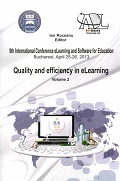CREATING AN INTEGRATIVE LEARNING ENVIRONMENT USING CONCEPTUAL MAPS IN PHYSICS LESSONS
CREATING AN INTEGRATIVE LEARNING ENVIRONMENT USING CONCEPTUAL MAPS IN PHYSICS LESSONS
Author(s): Claudia Daniela Cziprok, Florin F. Popescu, Cristina MIRONSubject(s): Education
Published by: Carol I National Defence University Publishing House
Keywords: Conceptual map; CmapTools; Ausubel's cognitive learning theory; Gas laws; Physics
Summary/Abstract: We believe that Ausubel's cognitive learning theory provides a strong basis for improving teaching and learning. This work presents the combination of constructivist epistemology, Internet use and CmapTools, a software toolkit for building conceptual maps to deepen the concepts of “gas laws”. Conceptual maps are a powerful tool not only for perception, representation and archiving of knowledge, but also to create new knowledge. It is essential to helping students understand that all concepts are somehow related to each other and to select cross-links as specific as possible and identify the most appropriate linking words to connect concepts, http://cmapspublic.ihmc.us/rid=1L77HZZH0-JJS3VW-1S6Q/0.Harta{DD594461-7D5B-4F4D-A99C-2CF65CB648C8}0conceptual%C46. Students who are involved in the construction of conceptual maps of physics are engaged in a creative process, and this can be challenging, especially for students who have spent most of their lives in learning by heart. The CmapTools Software Toolkit brings together the strengths of concept mapping with the power of technology, the Internet and World Wide Web. The software not only makes it easy for users to build and modify concept maps, but allows users to build their remote collaboration and publication, so that anyone can access with links to resources, to explain their content and other information for created conceptual map. CmapTools software tool can serve as a basis for a new kind of integration of Internet resources and all classroom experiences, physical laboratory, and outside them. If it is used in conjunction with conceptual maps designed to support learning, it provides a new educational model. In this present work we used activities that allow students to construct their own structure of conceptual map using a list of concepts also mapping activities that are required students to complete the gaps in the structure of incomplete maps to assess the connections they make between important concepts. Workspace is public. It can be seen at the IHMC Public Cmaps CmapServer under „Claudia Cziprok/Legile gazelor” folder (http://cmapspublic.ihmc.us/rid=1L81NZX99-11RWV1J-1SB4/3. Legile{DD594461-7D5B-4F4D-A99C-2CF65CB648C8}0gazelor).
Journal: Conference proceedings of »eLearning and Software for Education« (eLSE)
- Issue Year: 9/2013
- Issue No: 02
- Page Range: 537-542
- Page Count: 6
- Language: English

